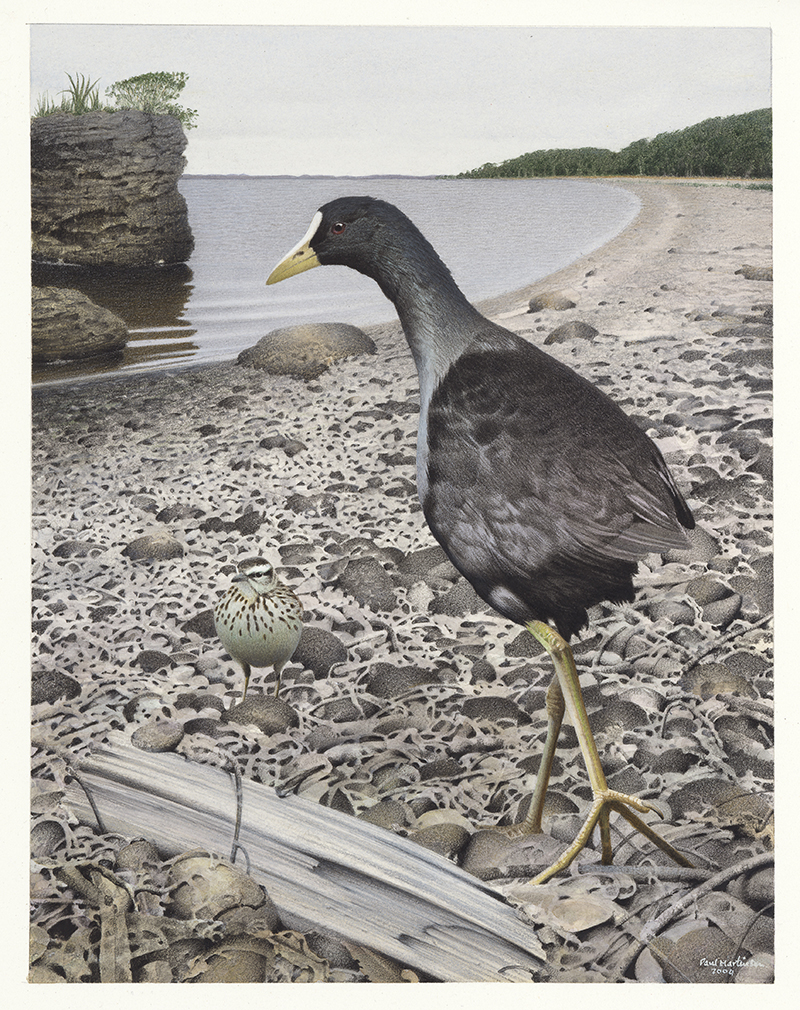Fulica chathamensis Forbes, 1892:252
Chatham Islands coot
Taxonomy & Nomenclature
Synonym/s: Fulica chathamensis chathamensis (Forbes, 1892:252); Palaeolimnas chathamensis (Forbes, 1892:252); Nesophalaris chathamensis (Forbes, 1892:252); Fulica chathamensis chathamensis Forbes, 1892:252
Conservation Status
Extinct
Last record: Holocene
Distribution
Chatham Islands, New Zealand
Biology & Ecology
Hypodigm
Media

Above: Chatham Island Coot. Fulica chathamensis. From the series: Extinct Birds of New Zealand., 2004, Masterton, by Paul Martinson. Purchased 2006. © Te Papa. CC BY-NC-ND 4.0. Te Papa (2006-0010-1/49)
References
Original scientific description:
Forbes, H. O. (1892). Aphanapteryx and other remains in the Chatham Islands. Nature 46: 252-253.
Other references:
Andrews, C. W. (1896). On the extinct birds of the Chatham Islands. Part II. The Osteology of Palaeolimnas chathamensis and Nesolimnas (gen. nov.) dieffenbachii. Nov. Zool. 3: 260-271.
Brodkorb, Pierce and Dawson, Elliot W. (1962). Nomenclature of Quaternary Coots from Oceanic Islands. The Auk 79(2): 267-269.
Checklist Committee (OSNZ). (2010). Checklist of the Birds of New Zealand, Norfolk and Macquarie Islands, and the Ross Dependency, Antarctica (4th ed.). Ornithological Society of New Zealand & Te Papa Press, Wellington. [p. 190]
Checklist Committee (OSNZ). (2022). Checklist of the Birds of New Zealand (5th edition). Ornithological Society of New Zealand Occasional Publication No. 1. Wellington: Ornithological Society of New Zealand. [p. 62]
Hamilton, A. (1893). On the fissures and caves at Castle Rocks, Southland; with a description of the existing and extinct birds found in them. Transactions and Proceedings of the New Zealand Institute 25: 88-106.
Holdaway, Richard N., Worthy, Trevor H. and Tennyson, Alan J. D. (2001). A working list of breeding bird species of the New Zealand region at first human contact. New Zealand Journal of Zoology 28: 119-187.
Hume, Julian Pender and Walters, Michael. (2012). Extinct Birds. London: T & AD Poyser.
Livezey, Bradley C. (1998). A phylogenetic analysis of the Gruiformes (Aves) based on morphological characters, with an emphasis on the rails (Rallidae). Phil.Trans. R. Soc. Lond. B 353: 2077-2151.
Millener, P. R. (1980). The taxonomic status of extinct New Zealand Coots Fulica chathamensis subspp. (Aves: Rallidae). Notornis 27(4): 363-376.
Millener, P. R. (1981). The subfossil distribution of the extinct New Zealand Coots Fulica chathamensis subspp. (Aves: Rallidae). Notornis 28(1): 1-9.
Millener PR (1999) The history of the Chatham Islands’ bird fauna of the last 7000 years—a chronicle of change and extinction. In Olson SL, ed., Avian Paleontology at the Close of the 20th Century: Proceedings of the 4th International Meeting of the Society of Avian Paleontology and Evolution, Washington DC ., 4–7 June 1996. Smithsonian Contributions to Paleobiology 89, 85–109.
Milne-Edwards, A. (1896). Sur les resemblances qui existent entre la faune des les Mascareignes et celle de certaines iles de l'Océan Pacifique Austral. Annales des Sciences Naturelles – Zoologie et Paléontologie S8(2): 117-136.
Olson, Storrs L. (1975). A review of the extinct rails of the New Zealand region (Aves: Rallidae). Records of the National Museum of New Zealand 1(3): 63-79.
Olson, Storrs L. (1977). A synopsis on the fossil Rallidae. In: Ripley, S. D. Rails of the World: A Monograph of the Family Rallidae. Boston: Codine.
Robertson, H. A., Baird, K. A., Elliott, G. P., Hitchmough, R. A., McArthur, N. J., Makan, T. D., Miskelly, Colin M., O’Donnell, C. F. J., Sagar, P. M., Scofield, R. P., Taylor, G. A. and Michel, P. (2021). Conservation status of birds in Aotearoa New Zealand, 2021. New Zealand Threat Classification Series 36. Department of Conservation, Wellington. 43 pp.
Hugh Robertson, John Dowding, Graeme Elliott, Rod Hitchmough, Colin Miskelly, Colin O’Donnell, Ralph Powlesland, Paul Sagar, Paul Scofield, Graeme Taylor. (2013). Conservation status of New Zealand birds, 2012. New Zealand Threat Classification Series 4. 22 pp.
Rothschild, Lionel Walter. (1907). Extinct birds: an attempt to write in one volume a short account of those birds which have become extinct in historical times, that is within the last six or seven hundred years: to which are added a few which still exist, but are on the verge of extinction. London: Hutchinson & Co. XXIX + 243 pp. [p. 149]
Sayol, Ferran, Steinbauer, Manuel J., Blackburn, Tim M., Antonelli, Alexandre and Faurby, Søren. (2020). Anthropogenic extinctions conceal widespread evolution of flightlessness in birds. Science Advances 6(49): eabb6095. https://doi.org/10.1126/sciadv.abb6095 [Supplementary Material (Data File S1)]
Smith, Ian. (1999). Settlement Permanence and Function at Pleasant River Mouth, East Otago, New Zealand. New Zealand Journal of Archaeology 19: 27-79.
Trotter, M. M. (1965). Avian remains from North Otago archaeological sites. Notornis 12(3): 176-178. ["Palaeolimnas chathamensis", but being from the South Island is more likely referable to Fulica prisca]
Tyrberg, Tommy. (2009). Holocene avian extinctions, pp. 63-106. In: Turvey, Samuel T. (ed.). Holocene Extinctions. Oxford, UK & New York, USA: Oxford University Press. xii + 352 pp.
Williams, G. R. (1962). Extinction and the land and freshwater-inhabiting birds of New Zealand. Notornis 10(1): 15-32.
Worthy, Trevor H. and Holdaway, Richard N. (2002). The Lost World of the Moa: Prehistoric Life of New Zealand. Bloomington, Indiana: Indiana University Press. xxxiii + 718 pp.
Wragg, Graham M. (1981). The birds of Canterbury: history and present status. A dissertation presented as a requirement for the Diploma in Parks and Recreation (National Parks option). Lincoln College, New Zealand.
